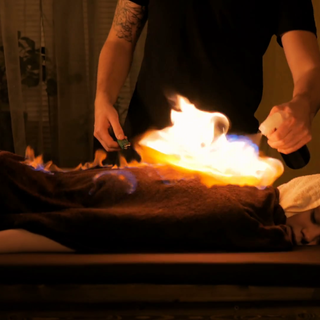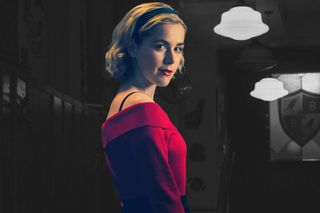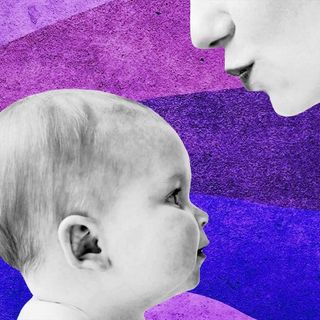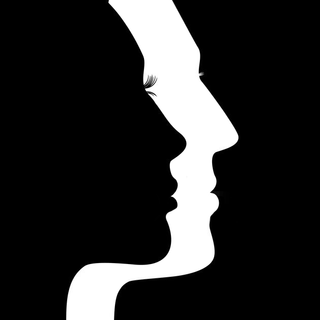
Netflix’s ‘Sabrina’ is Not the Woke Feminist Show It Thinks It Is
Its portrayal of ‘strong female characters’ might actually do more harm than good.

The holiday special of Chilling Adventures of Sabrina released this weekend, bringing back the now platinum-haired teenage witch and her Satan-worshiping family, just in time to wish us all a bright solstice. Enjoyable though it is, packed with those Christmas-special staples, like ghosts with unfinished business, diabolical demon Santas, and Icelandic children-eating witches, the episode feels shallow and unsatisfying in much the same way the rest of Season 1 does.
Despite the Netflix series being hailed as the feminist showwe need right now, its tokenizing, didactic approach just seems to be capitalizing on the fact that witches have been feminist icons in recent history. But using feminism as an aesthetic rather than the conceptual underpinning of the show, makes for a series that really fails at teaching young viewers what women’s empowerment is actually about.
Having an evil demoness who ‘feasts on the flesh of men’ say things like, “Women should be in charge of everything,” should not be aspirational in any way. While I will ironically embrace this kind of all-encompassing misandry any day of the week, this is not what feminism really looks like. Instead, it feels like the show is playing into the exact tropes that people use to vilify feminists — that they’re just trying to use reverse sexism (which is not a thing) simply to gain power.
Don’t get me wrong, it’s a great show to binge-watch. Teenage heartache combined with occult horror is definitely a winning combination. But let’s not ascribe lofty ideals and metaphors to Sabrina. The premise, based loosely on the original Archie comics character, is centered around Sabrina (Mad Men’s Kiernan Shipka), a half-witch, half-mortal, who is raised by her witch aunts, Hilda (Lucy Davis) and Zelda (Miranda Otto). The show begins near the eve of her 16th birthday, when she will have to decide whether to choose her mortal life, friends and boyfriend Harvey, or to join the Church of Night, sign her name and body away in the devil’s Book of the Beast, and become a full-fledged witch.
If it seems strange that witchcraft — purportedly centering the divine feminine — should look like a coven that worships the cloven-footed, half-goat deity Baphomet, and take orders from Father Blackwood (sounds more like puritanical monotheistic religion, huh?) no one really protests. Instead, the trade-off, of women’s freedom for magical powers is set up as Sabrina’s central battle — and she wants both. But when she says as much to another witch, Prudence, she’s told that the Dark Lord will never allow her, or any woman, to have both power and freedom. Why? “Because he’s a man, isn’t he?” Of course power, even imaginary demonic power, is always held by men.
While Sabrina’s witch life involves kneeling in a delicate white slip while an older man performs her dark baptism, her mortal life is also rife with men wielding power over her and her friends. At Baxter High, she’s infuriated when her gender non-conforming friend, Susie, is sexually assaulted by some footballers. When Principal Hawthorn refuses to help, Sabrina decides to hex him and start a club for women “to meet and bolster each other, where we can discuss issues and problems we’re facing and come up with proactive solutions.” She names this club the ‘Women’s Intersectional Cultural and Creative Association,’ or WICCA.
Between this ridiculous acronym and characters who casually drop phrases like ‘puritanical masculinity’ and ‘white patriarchy,’ it’s difficult not to bang your head against your copy of Audre Lorde’s Sister, Outsider. The work of intersectional feminism is not complete just because you name it, neither is the work of toppling the white patriarchy, but unfortunately the series moves swiftly from moments of cursory soapbox feminism to the next scene, where someone is performing a cannibalistic ritual, without ever trying to dig deeper.
Kudos to Sabrina for actually casting a gender non-conforming person (Lachlan Watson) to play a gender non-conforming character, but that’s where the congratulations stop. The token queer and black best friends are afterthoughts to the plot, there to get into sticky situations so that Sabrina can play out all her white-savior dreams by rescuing them.
Meanwhile the other characters of color, like Prudence and Sabrina’s pansexual cousin, Ambrose, have much more intriguing backstories that simply aren’t given enough screen time. The trajectory of witch history that the show covers only references the Salem witch trials and white women as victims. By solely focusing on this, Sabrina ignores the very real history of colonizing Christians who condemned ‘natives’ as devil-worshipers and witches. It was mostly people of color who were marked by ‘witchcraft’ and enslaved, marginalized, and killed because of it. To erase this history of violence while talking about intersectionality is disrespectful — at best.
Instead, the hero of our story is always Sabrina, which gets pretty repetitive as the episodes continue — she is the only girl with the power to save the day, every day, challenging male power in witch and mortal arenas. However, as she gets increasingly angry, Sabrina’s rage is channeled into magic, transforming her from her do-gooder avatar to the platinum-haired witch who will go to any lengths to restore what she sees as justice. In a post #MeToo world, where women are often criticized for taking justice into their own hands and running amok with power, it’s difficult not to see this plot twist as yet another way Sabrina actually reiterates the status quo, rather than disrupting it as promised.
Nadia Nooreyezdan is The Swaddle's culture editor. Since graduating from Columbia Journalism School, she spends her time thinking about aliens, cyborgs, and social justice sci-fi. She's also working on a memoir about her family's journey from Iran to India.
Related


Is This Normal? “I Love to Smell Newborn Babies!”
